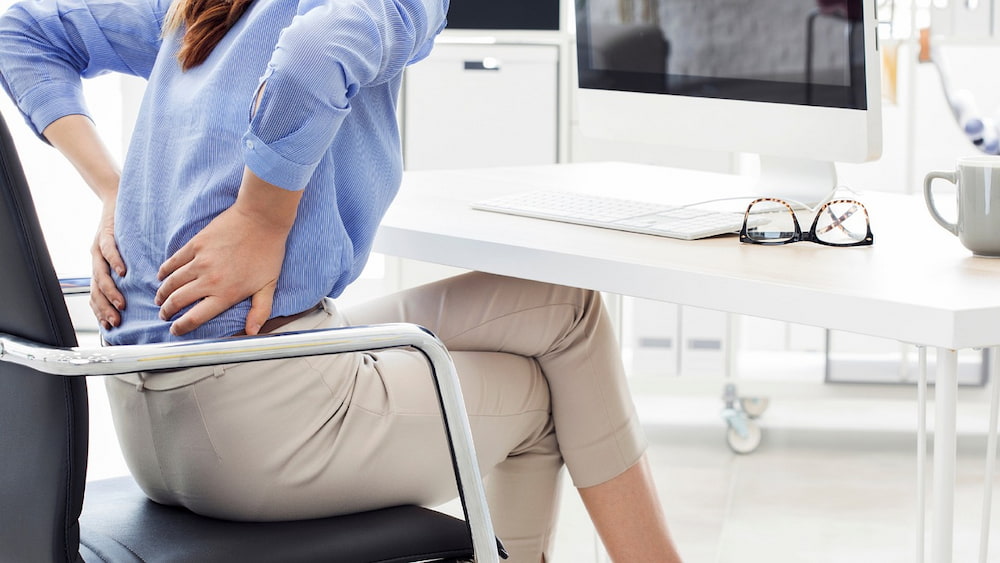Back pain, a common discomfort that plagues many individuals, can be effectively prevented or managed with simple lifestyle adjustments and self-care practices. Maintaining good posture, taking regular breaks from prolonged sitting, and incorporating stretches and exercises into your routine can significantly achieve the objective on how to prevent back pain when sitting.

What To Know About Lower Back Pain When Sitting
The exact cause of back pain is often elusive, but muscle spasms are believed to be the most common culprit. This is according to Harvard Medical School.
While there is no definitive evidence from medical studies that sitting directly leads to more spasms, people often experience tighter and more painful back muscles after prolonged periods of sitting.
The reason behind this phenomenon lies in the biomechanics of the spine and the muscles that support it. When we sit, the natural curvature of our spine is flattened, placing increased strain on the muscles and ligaments in the lower back. This prolonged strain can lead to muscle fatigue, spasms, and ultimately, pain.
Back pain related to sitting should not be taken lightly because it could be an indicator of a common condition. Continue reading to find out.
What Causes Back Pain When Sitting

1. Posture
The Oxford University Press stresses that back pain is frequently caused by postural defects, which occur when the natural alignment of muscles, bones, and other tissues in the back is disrupted. This misalignment can put excessive strain on certain muscles and joints, leading to pain, discomfort, and stiffness.

2. Injury
According to the National Institute of Arthritis and Musculoskeletal and Skin Diseases (NIAMS), back pain can be caused by a variety of mechanical or structural problems in the spine, discs, muscles, ligaments, or tendons. These problems can range from minor injuries, such as sprains and strains, to more serious conditions, such as herniated discs and spinal stenosis.

3. Sciatica
Sciatica is pain that originates along the sciatic nerve, which is the largest nerve in the body. The pain radiates from the lower back to the buttock and down the leg. Sciatica is usually caused by a herniated disk in the spine that presses on the sciatic nerve. This is according to Johns Hopkins Medicine. Essentially, lower back pain is a symptom of sciatica where the situation applies.

4. Herniated Disk
According to the American Association of Neurological Surgeons, the spinal canal’s confined space is insufficient to accommodate both the spinal nerve and the displaced herniated disk fragment.
As a result of this displacement, the disc exerts pressure on the surrounding spinal nerves, frequently resulting in pain that can be severe.

5. Degenerative Disk Disease
Disk degeneration is strongly associated with low back pain. Multiple studies have shown that disc degeneration is a major contributor to the development of back pain.

6. Muscle Strain
Lumbar strain is an injury to the lower back that can cause pain and soreness. It is caused by damage to the tendons and muscles in the lower back.
The tendons and muscles can be damaged by pushing and pulling sports, such as weight lifting or football, or by sports that require sudden twisting of the lower back, such as in tennis, basketball, baseball, and golf.
The pain from lumbar strain is usually felt in the lower back, but it can also radiate to the buttocks, thighs, and legs. The pain is typically worse with movement and may be accompanied by muscle spasms.

7. Weight
Carrying excess weight can have a significant impact on your spine and joints. Imagine every pound of weight you carry translates to four times that amount of pressure on your spine. So, if you weigh 90kg/198lbs, your spine is effectively bearing the weight of 363kg/800lbs. This constant strain can lead to back pain and other problems.
In a study conducted by a group researchers entitled The Association Between Obesity and Low Back Pain: A Meta-Analysis and published at the American Journal of Epidemiology, they concluded that obesity is associated with an increased risk of low back pain.
6 Preventive Tips to Back Pain
While there is no one-size-fits-all solution to preventing back pain, there are a number of things you can do to reduce your risk. Here are 6 tips:

1. Perform Stretches and Exercises
Regular stretching and exercise help improve flexibility and strength in the muscles that support your back. This can help to reduce pain and prevent future injuries. There are a number of different stretches and exercises that can be beneficial for back pain. The following are some of the most common:
The Plank
- Start in a push-up position, with your forearms on the ground and your elbows directly under your shoulders.
- Keep your back straight and engage your core muscles.
- Hold for 30 seconds to a minute.
The Bird Dog
- Start on your hands and knees, with your hands shoulder-width apart and your knees hip-width apart.
- Extend your right arm forward and your left leg back, keeping your back straight.
- Hold for 5 seconds, then switch sides.
The Arch
- Lie on your back with your knees bent and your feet flat on the floor.
- Press your lower back into the ground and lift your hips off the floor, forming an arch with your back.
- Hold for 5 seconds, then lower your hips back to the ground.

2. Change Your Position from Time to Time
If you sit for long periods, you must get up and move around every 20-30 minutes to avoid muscle stiffness and pain.

3. Use a Support
Placing a rolled-up towel or special lumbar pillow at the base of your spine while sitting helps to keep your back in a healthy alignment and reduce pain.

4. Consider Yoga
Yoga is a great way to stretch and strengthen the muscles in your back. It can also help to improve your posture and flexibility.

5. Get a Good Massage for your Lower Back
A massage helps to relax the muscles in your back and improve blood flow. Thus pain and inflammation are reduced.

6. Invest on a Quality Tested Ergonomic Chair
An ergonomic chair helps support your back in a healthy alignment and reduce pain. When choosing an ergonomic chair, be sure to look for one that is adjustable and has good lumbar support.
Ergonomic kneeling chair is one good example as it is known to eliminate neck and back pains especially for those working long hours on the computer. By sitting in a sloped position, your weight is evenly distributed on your back, neck and shoulders eradicating the source of muscle strain.
When to See a Doctor
Consult a healthcare professional if your lower back pain is severe, persistent, or does not respond to self-care measures such as stretches, exercises, and other home remedies.
Final Thoughts
Back pain is a common complaint from people who spend a lot of time sitting down. It’s a good thing that one can take preventive measures, such as maintaining good posture, to minimise the risk of back pain. When back pain does occur, a variety of self-care techniques, including stretches and exercises, can often provide effective relief.
- 6 Benefits of Using Seat Cushion - February 20, 2024
- 4 Tips to Fix Uncomfortable Chair - February 19, 2024
- How to Position Lumbar Support on Ergonomic Chair - February 15, 2024

